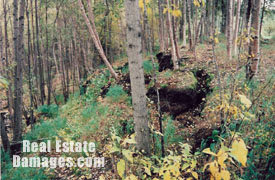Although 150 miles from the epicenter, Anchorage suffered the most extensive damage because the city straddles the fault line. Deep crevasses and fissures occurred throughout the area, entire city blocks broke off towards the coastline, and many homes tumbled into the ocean. The earthquake caused large tidal waves as high as 90 feet, which amplified the destruction of some coastal towns and villages. The earthquake damaged boats, barges, the fishing industry and much of the transportation infrastructure. In Anchorage, 215 homes were totally destroyed and 157 commercial buildings were destroyed or condemned. 50% to 60% of the water lines, 15% of the sewer lines, and 50% of the cities' streets, curbs, gutters, and sidewalks were severely damaged. Two major slides occurred. One slide dropped a full block of 4th Avenue, the main business street, 20 to 30 feet down into the earth. The other landslide destroyed Turnagain-by-the-sea, a high-priced housing area that overlooks Knik Arm, and threw many homes into the Cook Inlet. In Seward, an oceanfront community south of Anchorage, the earthquake ignited several oil storage tanks. The town lost 95% of its railroad, which impacted all of Alaska as it served as the railhead of the Alaskan railroad. The city had a mile-long area collapse into the sea. The earthquake and subsequent tidal wave caused approximately $1 billion in damage (unadjusted for inflation).
The Town of Seward also suffered enormous destruction from subsequent tidal waves. Numerous homes and businesses were swept away into the ocean. That residential area is vacant today, and much of the destroyed downtown areas are used for recreational vehicle parking. The only residential development within the damaged zone has been rented, low-income housing. Some homes located off the coastline now enjoy outstanding ocean front views, and as a result of the tragedy, their values were enhanced. Although the same risk for another tidal wave, as in 1964, exists today, a $60 million ocean research and aquarium facility began construction in 1996 on lower-risk areas of the coast. The tidal waves also hit Valdez, a small town later made famous by the Exxon Valdez Oil spill. Much of the town was destroyed, although several homes and businesses did survive the waves. Later, the entire town was uprooted and moved a few miles to a new town site that was not impacted. Nearly every building that was not destroyed was eventually moved to the new town, and the old original town site is currently vacant, with only some concrete foundation remnants remaining. The local visitors center offers tourists a walking tour map of the various homes and businesses that were moved from the old town site. The entire town suffered a significant loss due to the cost of destroyed buildings and the cost of relocating the remaining buildings to the new town site. The moving of an entire town was not an isolated incident. Another village that was damaged by the earthquake and tidal waves was moved to Evens Island.
|

